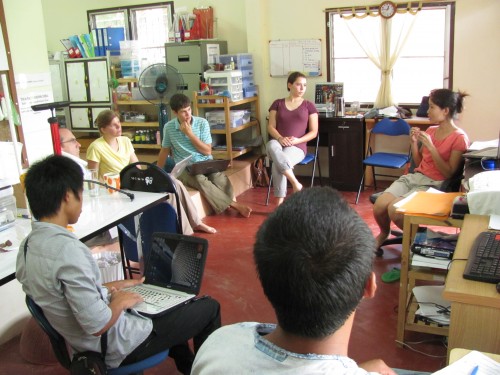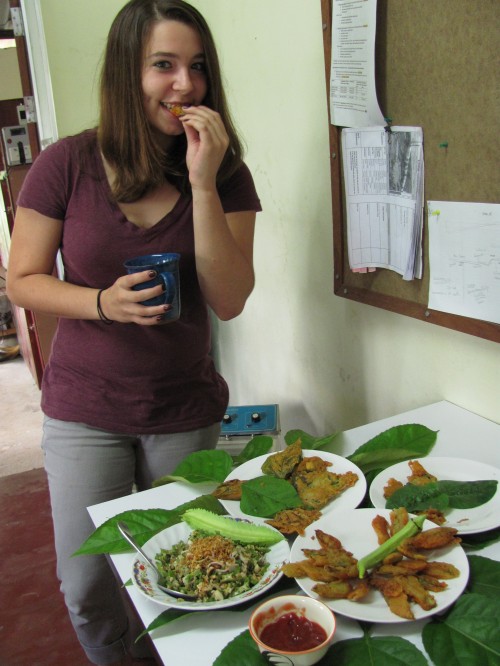What we’ve eaten at the past three meetings…

Our monthly meetings are spiced up by food cooked by local village chefs (aka friends' grandmas who live 30 minutes away)

NextGEN Gallery Plugin Not found
What we’ve eaten at the past three meetings…

Our monthly meetings are spiced up by food cooked by local village chefs (aka friends' grandmas who live 30 minutes away)

I completed this labour of love in July and it was recently broadcast to our ECHO Asia network. Â I’m thrilled because it’s the first comprehensive listing of our seed bank offerings to send out to people working in the field with poor communities. Â And it’s exciting to think of how so many local, order open-pollinated food plants we’ve collected that have the potential to help people grow food or generate income.
June marks the 8th month into my 3rd year in Thailand! Â It’s amazing how time flies and creeps by at the same time.
I haven’t posted anything since April, ascariasis so I’m getting back into the blogging groove with a post from Rick Burnette’s (he’s my boss) blog Waiting on the Rainy Season.
Click here to find out what these cute spoons are doing at our seed bank 🙂
My friend Brenda is a farmer back home in Ontario and her neighbour came out to the seedbank a few weeks ago to visit. Â Jon’s an organic farmer who produces mushrooms using an old Japanese method and asparagus, urticaria among other things. Â It was terrific to talk farming with someone who’s been in the business for over 25 years; he ended up writing an article on our seedbank so check it out!
I’ve been going through reams of books and countless databases as part of my research for our seed catalogue that we hope to open on-line in April (gulp!). Â I came across this simple but comprehensive video on the rice bean (Vigna umbellata) and why it benefits the poor, about it subsistence farmers who grow in the the mountains of Nepal.
It’s a neglected, thumb under-used crop that has so many advantages in making soil better, visit web feeding animals, and as a good food source…we LOVE these characteristics at the seedbank!  Rice bean is part of our seedbank inventory and we source it from local farmers in Chiang Dao district. Take 10 minutes and watch it!  Reminds me so much of the folks we work with here in northern Thailand.
Three months into my work setting up the seed bank for ECHO Asia and I’m still grasping the overall scope of the project. Â I continue to try to adapt my Type A and western working style to the slower pace (some might say relaxed, see I just say slow) at UHDP – where the ECHO seed bank is based. Â I might sound less optimistic than other posts, perhaps a tad cynical but I’m beginning to comprehend the frustrations of being a foreigner working in Thailand, no matter that I’ve been here for over a year.
Working on a technical project using my conversational Thai borders on the absurd at times. Â Fortunately Leu and I are developing our own way of communicating using both basic Thai and English. Â But witness my attempts to discuss custom-building a seed drying cabinet with the local carpenter and electrician – they are northern Thai but I don’t speak their dialect at all; their central Thai is so littered with northern Thai that I barely understand. Â I used pictures on my computer, maniacal hand gestures to indicate height and a hand drawn blueprint to communicate. Â The result (see above) would make any of you ergonomics/human usability folks cringe – if the top door opens, it unlatches the other very heavy doors and will cause the bottom door to drop on your foot if you don’t step away in time – this happened to poor Leu. Â TIT, folks, TIT (this is Thailand). Â But because I’m a half-glass full kind of gal, it’s another lesson learned in patience and improving my communication skills for the next construction project. Â I did talk to the carpenter afterwards and he changed the ways the doors are closed so no more broken feet!
The concept of team work is so much more important to me now, as I realize just how big this seed bank project is. Â Each of us have various important roles to play and to do well: Leu plants, harvests, weeds, cuts grass, inspects the plants and is really handy at building fences. Â My strengths are in prioritizing tasks, seeing where we need extra help, creating materials to teach Leu about seed bank procedures, documenting and being liaison between Rick (at headquarters 4 hours away in Chiang Mai) and our seed bank team. Â Phoebe is in charge of experimenting with vaccuum sealing as a method of storing seeds – her final report will be important evidence in proving that certain methods of storage are better than just sticking seeds in a plastic bag.
Seed bank work is tedious and frustrating – two steps forward and ten steps back. Â It is frustrating to be held captive by the life cycle of plants – I am so NOT a farmer – Â and the limitations of my language. Â There is no glamour at all in what I do (not that that was the reason I’m doing this) and more often than not, I feel completely ineffective and unproductive. Â It was reassuring to hear from Leu that he feels the same way. Â But we have our work cut out for us and that’s just what it is: hard work. Â I hope I can report good things next time I write about the seed bank.